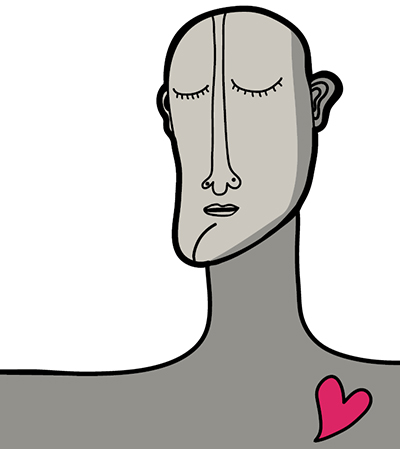
This is an excerpt of a workshop coordinated by VÉRONIQUE BRASSELET and EMMA MILESI during the Heartfulness days at the Cité Internationale in Lyon in January 2016.
The Heart’s Simplicity Reduces Stress
Stress is everywhere in our daily lives. When it is positive (eustress), it is considered beneficial; when it is negative (distress), it inhibits our potential and prevents us from accomplishing our objectives.
What is stress?
Stress is something that causes a state of strain or tension.
What hides behind stress?
Our fears. Fear is part of daily life, and it is present everywhere. According to its intensity, stress will be more or less severe, uncomfortable, challenging, or crippling.
Various sources of stress
1. Daily worries — for example, missing the bus and arriving late, or being unable to finish all that was planned for the day.
2. Undergoing fear — for example, speaking in public, being interviewed for a job, not reaching our parents’ expectations, or required job performance.
3. Undergoing binding, sometimes crippling fear — for example, reliving an old wound that made us suffer. Examples include not being loved, being abandoned, failing, hurting others, or the fear of being judged by others.
4. The growing pace of life — for example, fear of anything new, of change, or of not adapting.
Fear/Stress is a film we create for ourselves, a mental scenario, which confines us to a narrow vision excluding reality. Our interpretation distorts reality into false beliefs about ourselves and others.
Stress, in particular distress, reveals that something is not quite right, and allows us to question ourselves: “What is causing me to feel stressed or frightened?”
Various Reactions Under Stress
Our survival instinct forces us to act in one of three ways: defend ourselves, flee, or stay dumbstruck on the spot!
Stress acts specifically at different levels
1. The Brain
 Stress specifically targets the brain areas implicated in coordinating cognition and emotions:
Stress specifically targets the brain areas implicated in coordinating cognition and emotions:
a) The cognitive functions coordinated by the prefrontal cortex, such as language, memory, and the ability to reason, plan, and organize.
b) Adaptability — calmness, problem solving, and decision-making.
c) Emotions, such as aggression, fear, and pleasure, controlled by the limbic system.
According to the degree of stress, we more or less lose these faculties, and this can lead to lack of spontaneity, to depression, and even to psychomotor retardation.
The limbic system is the seat of our impulses, fears, and angers. It emotionally colours any information received and grades it as agreeable or disagreeable. Its main function is survival by suitable adaptation to the social environment. Under stress, it focuses on survival — fight or flight — and deprives us from thinking clearly, e.g. blank page syndrome.
Consequently, with stress (distress), we lose our capacity for reflection, and emotions take over. Take, for example, a job interview; some will have clammy hands while others will not turn up, the stress being too unbearable.
How Does the Brain Treat Information?
Imagine your brain as a multi-storey house.
First of all, information goes to the reptilian brain, the instinctive brain. If the body is in survival mode, as when you are hungry, for instance, the information will be slowed down, even completely blocked if the hunger is severe. If body survival is not threatened, the information moves to the second storey into the limbic system, the emotional brain.
Here the information is classified as agreeable or disagreeable. If it is agreeable, it passes through to the cortex and then you may have an answer to your mathematics problem! If it is considered disagreeable, failure is guaranteed! In the worst of cases, the limbic system will not allow the information to pass to the cortex.
How does the limbic system assess information? Like an arbitrator, it adds up the plusses and minuses.
For each disagreeable thought it allocates a minus, and for each agreeable thought it allocates a plus. Say you have a math problem. If you say, “I am hopeless at math,” or “This teacher is poor,” or “My family has never been good at math,” it is a minus. If, on the other hand, you are feeling positive, then you create a plus.
To continue the metaphor of the multi-storey house, let’s say there is a door to go from the limbic system to the cortex. The plusses try to open the door, while the minuses try to shut it. The team that has the most wins.
What does a team coach do before a football match? He talks positively to the players, saying, “We will win,” and “We are the best,” so the information passes directly to the cortex and the team can play at its best level.
In fact, when information is considered agreeable or very agreeable by the limbic system, the limbic system passes it to the cortex, and then the cortex deals with it as a priority.
2. The Hormones
The hormones adrenaline and noradrenalin are released in stressful situations, and they accelerate our heart rhythm and breathing to allow the organs linked to movement to increase their functions and thus to support defence or escape.
3. Behaviour and Emotions
Stress leads to:
- Dependency, jealousy, withdrawal, and even submission,
- Withdrawal due to fear of showing weaknesses and not meeting expectations
- Difficulty in saying no, tendency to avoid conflicts,
- Hindrance of all action and relations,
- Withdrawal due to sadness and despondency,
- Compensation, such as eating disorders, drinking, and smoking.
Activity: How to Liberate Stress in Four Stages
 Ask a friend to guide you through the steps.
Ask a friend to guide you through the steps.
Step 1: Observe it
Put yourself at ease, breathe calmly, and close your eyes. Observe any current stress that you feel.
Identify the emotions that take place inside you when you are aware of that stress.
Identify the physical symptoms that appear, such as sweating, breathing, clammy hands, etc.
Identify how you react to this stress: Do you run away, stand up to it, or become inert?
Note the stress level on a scale from 1 to 10.
Breathe in slowly and deeply through your nose, and breathe out through your mouth.
Step 2: Feel it
Recognize it, expressing inwardly, “I feel stressed because…”
Inhale slowly through your nose, and exhale through your mouth.
Feel this stress as deeply as possible, so as to integrate it.
Feel the emotions that surface. We are often afraid to feel these emotions because we think they are bad and we will become like that.
Inhale slowly through your nose, and exhale through your mouth.
Step 3: Accept it
Welcome your stress without judging and with benevolence, as it is part of you.
Inhale slowly through your nose, and exhale through your mouth.
Accept it. What feelings occur when you do? What physical changes do you observe?
Welcome this new sensation, explore it, appreciate it, amplify it while breathing naturally, let it spread throughout your body, and feel the energy circulating.
Step 4: Integrate it
Do you feel that something has changed or loosened?
Be ready to listen to a new understanding.
Bring your attention again to the same stress: How do you feel now with it? If there is no improvement, wait some time and if necessary, try again.
Note the stress level that you feel now on a scale of 1 to 10.
Thank yourself that you took care of yourself.
When we take the time to welcome what happens inside us and acknowledge it, we digest it better. We give ourselves permission to live in the present. Then, slowly, we will accept it, integrate it, and then transcend it.
This is our personal work.
When we cut ourselves off from our feelings, we try to stand back and intellectualize, and then our emotions take over. To free ourselves from our stresses is a proof of maturity and wisdom.
Article and activity by VÉRONIQUE BRASSELET and EMMA MILESI
Get Your In Depth Numerology Reading
Your life path number can tell you A LOT about you.
With the ancient science of Numerology you can find out accurate and revealing information just from your name and birth date.
Get your free numerology reading and learn more about how you can use numerology in your life to find out more about your path and journey. Get Your free reading.
Source Article from http://feedproxy.google.com/~r/Collective-evolution/~3/jJBr6StM8IE/
 RSS Feed
RSS Feed















 August 8th, 2017
August 8th, 2017  Awake Goy
Awake Goy 
 Posted in
Posted in  Tags:
Tags: 













